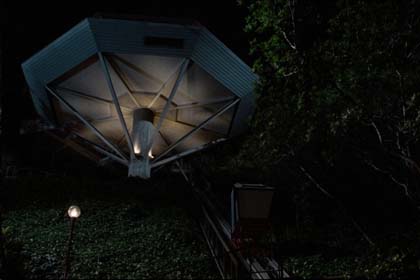LA TIMES ON 'THE TRIBE' SHOOTING STYLE
ONE PART EASTERN EUROPEAN (GLOOMY TABLEAUX), ONE PART DE PALMA (VOYEUR), WITH A DASH OF SCORSESE (GANGSTER KINETICS) Los Angeles Times' Robert Abele
Los Angeles Times' Robert Abele reviews
The Tribe:
"There's nothing like
The Tribe, the astounding debut feature from Ukrainian writer-director
Myroslav Slaboshpytskiy about a mob operating within a crumbling school for the deaf. One need not read it as a metaphor for the director's homeland to appreciate the movie as a tour de force.
"The Tribe is a vortex of filmmaking style and humanity's darker impulses, during which you may find yourself clawing the seat to resist its severe, sometimes exceedingly graphic pull. But denying its power is tough. A former crime reporter, Slaboshpytskiy has made one of the most unusual and disturbing films about criminality of the new century.
"Before the first image appears, the movie warns you of its gimmick: The characters all communicate in sign language, with no subtitling or narration. As raw as that deal may seem between an ambitious director and foreign-film audiences normally unfazed by language barriers, Slaboshpytskiy uses it to free up his visual storytelling and direction of actors, which is nearly always illuminative.
"It also fosters an abiding appreciation for the gesticulative art of the all-deaf performers, whose interactions — whatever the emotion at hand — have the expressiveness of choreography. Be assured, there's no lack of narrative clarity here, only the persistent sense that nothing cheerful is in store...
"The Tribe is marked not just by wordlessness — the ambient sound makes it not truly silent — but by Slaboshpytskiy's mesmerizing long takes. Each one is a mini-drama of movement, suspense and revelation, whether tracking characters around the rooms, hallways and grounds of the school, or parked in one spot for a scene of mischief, conversation, explicit sex, or, late in the film, an excruciating real-time abortion. It's shooting style, patient yet predatory, that feels one part Eastern European directors' penchant for protractedly gloomy tableaux, one part Brian De Palma in voyeur mode, with a dash of Martin Scorsese articulating the kinetics of gangster life.
"The film is made up of only 34 shots — fewer cuts than Michael Bay would use to film a commercial. But stitched together, the effect is bracingly alchemic in connecting us to a corrosive world, and characters for whom the mobility of sight is everything. Few first films have so confidently executed such a formalist approach to visuals and communication."
 Inspired by the new season of True Detective, Vulture enlisted New York Magazine design expert Wendy Goodman to compile a list of great modernist houses in which Los Angeles villains have taken up residence. (Greg Cwik co-wrote the Vulture article with Goodman.) John Lautner's Chemosphere House, built in 1960, is a prominent setting of Brian De Palma's Body Double, which comes in at number six on the list of eight.
Inspired by the new season of True Detective, Vulture enlisted New York Magazine design expert Wendy Goodman to compile a list of great modernist houses in which Los Angeles villains have taken up residence. (Greg Cwik co-wrote the Vulture article with Goodman.) John Lautner's Chemosphere House, built in 1960, is a prominent setting of Brian De Palma's Body Double, which comes in at number six on the list of eight.




 The film world was rocked by tragedy late last night when it was reported that James Horner, Oscar-winning composer of the scores for Titanic, Braveheart, and many other films, died in a plane crash in California. He was 61. According to
The film world was rocked by tragedy late last night when it was reported that James Horner, Oscar-winning composer of the scores for Titanic, Braveheart, and many other films, died in a plane crash in California. He was 61. According to  Colin Cameron, who portrayed the onscreen bass player for the ever-evolving house band in Phantom Of The Paradise, has passed away after a long illness. He was 73. Cameron was a member of Paul Williams' band in the 1970s, which is how he and others in Williams' band found themselves pretending to play their instruments as part of the Juicy Fruits and the Beach Bums in Phantom. While several of the other musicians did play on the Phantom soundtrack, Cameron actually did not. Even so, Cameron was a highly-respected fluent bass player who you can hear playing bass on the Williams-penned songs in The Muppet Movie, and who played on soundtracks and records by Quincy Jones, Henry Mancini, Cher, Tina Turner, Kris Kristofferson, Del Shannon, Olivia Newton-John, and many many others. Over at
Colin Cameron, who portrayed the onscreen bass player for the ever-evolving house band in Phantom Of The Paradise, has passed away after a long illness. He was 73. Cameron was a member of Paul Williams' band in the 1970s, which is how he and others in Williams' band found themselves pretending to play their instruments as part of the Juicy Fruits and the Beach Bums in Phantom. While several of the other musicians did play on the Phantom soundtrack, Cameron actually did not. Even so, Cameron was a highly-respected fluent bass player who you can hear playing bass on the Williams-penned songs in The Muppet Movie, and who played on soundtracks and records by Quincy Jones, Henry Mancini, Cher, Tina Turner, Kris Kristofferson, Del Shannon, Olivia Newton-John, and many many others. Over at 

 An interesting excerpt from an Cannes 2015 interview with Louder Than Bombs director Joachim Trier, posted yesterday by
An interesting excerpt from an Cannes 2015 interview with Louder Than Bombs director Joachim Trier, posted yesterday by  Christopher Lee died over the weekend at the age of 93. In 2001, at the age of 79, when he was in the midst of making films with George Lucas, Peter Jackson, and Tim Burton (among others), Lee talked to
Christopher Lee died over the weekend at the age of 93. In 2001, at the age of 79, when he was in the midst of making films with George Lucas, Peter Jackson, and Tim Burton (among others), Lee talked to  Director Nicolas Winding Refn has partnered with Milan Records to create a line of deluxe vinyl soundtrack LPs, curated by Refn himself. NWR editions of Oldboy and It Follows are now joined by the soundtrack to Refn's own Bronson, which was released yesterday. July 14 will see the release of Basil Poledouris’ score for Paul Verhoeven's RoboCop.
Director Nicolas Winding Refn has partnered with Milan Records to create a line of deluxe vinyl soundtrack LPs, curated by Refn himself. NWR editions of Oldboy and It Follows are now joined by the soundtrack to Refn's own Bronson, which was released yesterday. July 14 will see the release of Basil Poledouris’ score for Paul Verhoeven's RoboCop.